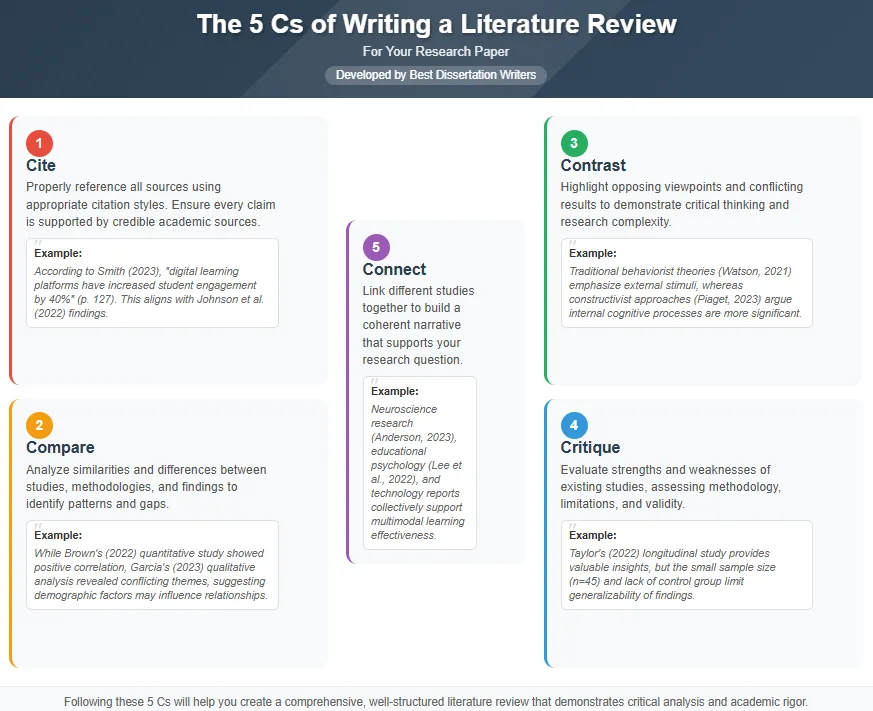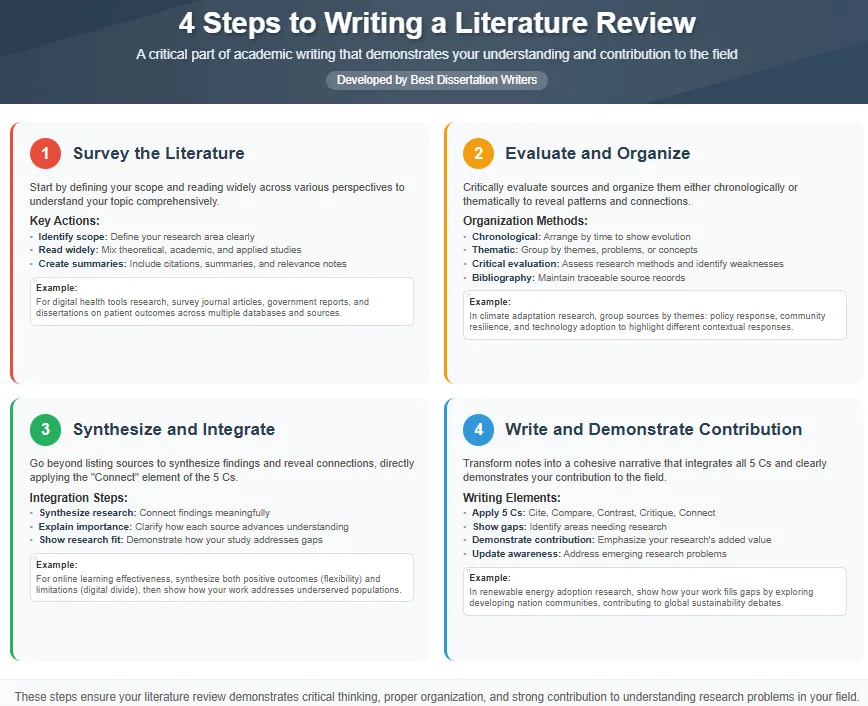What Is Are The 5 Cs of Writing a Literature Review?
- The 5 Cs of writing a literature review offer structured steps to writing a literature that improve clarity, rigor, and relevance in a research paper.
- Use them to organize your literature review as a thematic review that addresses a research problem, sharpens your research question, and strengthens academic writing in the social sciences and beyond.
- In practice, you will draw upon previous research, evaluate research methods, synthesize findings expressed in the literature, and explain the sources’ importance to your area of research.
- The “five ‘c’s,” often written as the “c’s of a literature review” or the “‘c’s of writing a literature,” are a practical scaffold for literature review writing in a thesis or dissertation.
Cite: Accurate Referencing and Building a Bibliography
- Purpose: The first C in the 5 Cs of writing a literature review is to Cite correctly so readers can trace the research studies you use.
- How: Maintain a consistent style and a complete bibliography; reference seminal and recent related research; include details on research methods when relevant.
- What to note: Proper citation demonstrates credibility and avoids plagiarism while signaling how the literature you are reviewing supports your research question.
- Example: In a research paper on mindfulness in classrooms, accurately cite randomized controlled trials and meta-analyses, then list them in the bibliography so readers can verify findings expressed in the literature.

Compare: Map Patterns and Similarities Across Studies
- Purpose: The second C in the 5 Cs of writing a literature review is to Compare and show converging evidence across research studies.
- How: Compare within the literature by grouping studies by theory, method, population, or outcome; identify shared trends in research methods and results.
- What to note: Literature reviews are designed to reveal how related research collectively addresses the research problem.
- Example: When writing a literature review on flipped learning, note that multiple quasi-experimental studies report improved critical thinking; summarize the shared pattern and the common instructional design features that drive gains.
Contrast: Highlight Differences, Debates, And Gaps
- Purpose: The third C in the five ‘c’s of writing is to Contrast disagreements, limitations, and open questions.
- How: Identify conflicting results, alternative explanations, or different operationalizations; separate contradictions due to sampling, measures, or contexts.
- What to note: Contrasts reveal genuine gaps that justify your study’s contribution to the area of research.
- Example: In screen-time research, some longitudinal studies link high use with lower attention, while others, using time-use diaries, find null effects; explain the sources’ importance by showing how measurement choices and cultural context likely drive the divergence.
Critique: Appraise Methods, Quality, Bias, And Limitations
- Purpose: The fourth C in the 5 cs (the “c’s”) is to Critique—that is, critique the literature rather than only describe it.
- How: Evaluate internal validity, external validity, sampling frames, instruments, analytic strategies, and risk of bias; balance strengths and weaknesses.
- What to note: A transparent critique clarifies what can and cannot be inferred from previous research and signals how your dissertation or study will improve on it.
- Example: You might praise a randomized field trial’s causal design yet note limited generalizability because the sample is from a single district; you might also identify publication bias in small-study effects.
Connect: Synthesize Themes to Advance Argument and Purpose
- Purpose: The final C in the 5 Cs of writing a literature review is to Connect the evidence and synthesize implications for your research question.
- How: Integrate converging and diverging strands into a coherent model; align themes to the research problem and outline how your methods extend related research.
- What to note: This is where you organize your literature review into a logical rationale that leads to study aims, hypotheses, and design choices.
- Example: After comparing and contrasting mindfulness studies, connect the pattern: benefits cluster around attentional control in middle school. You propose a mixed-methods study that adds ecological momentary assessment to address prior measurement limits, thereby advancing the argument.
- In sum, the 5 Cs of writing a literature review—Cite, Compare, Contrast, Critique, Connect—guide rigorous literature review writing. Applied together, the five ‘c’s help you frame the research problem, justify methods, and craft a compelling research paper that clearly explains the sources’ importance and advances knowledge in the social sciences.
Literature Review Writing Services
Get expert help from Best Dissertation Writers—our team delivers precise, customized, and plagiarism-free literature reviews that strengthen your dissertation and showcase your research. Achieve academic excellence today!
4 Steps to Writing a Literature Review
When you are writing your review, remember that a literature review is a critical part of any type of academic writing.
It shows your understanding of the topic, places your academic research in the context of its contribution, and demonstrates to your readers how your work in the context of the field of study expands knowledge.
The 5 Cs of writing a literature review—Cite, Compare, Contrast, Critique, and Connect—remain essential, but the following four steps break down how to apply them when researching a particular topic.
By following these steps, your literature review demonstrates critical thinking, proper organization, and a strong contribution to the understanding of new or emerging research problems in your area of research and investigation.
Step 1: Survey the Literature
- Identify the scope: Start with a literature review survey that helps you define the particular topic or area of research and investigation. A good literature review is organized around a topic and reflects the understanding of the subject.
- Read widely: Explore a mix of theoretical literature review sources, academic research, and applied studies. Make sure you have reviewed the literature across various perspectives.
- Use point form summaries: For each source you explore, create notes that include:
- Citations must be in-text to maintain academic integrity.
- A short summary of what is said in the literature.
- How it relates to your field of study.
- Example: If you are researching a particular topic like digital health tools, survey journal articles, government reports, and dissertations that synthesize existing research on patient outcomes.
Step 2: Evaluate and Organize
- Critical evaluation: This stage means to evaluate the literature and conduct a critical evaluation of these works. Identify whether the researching a particular topic was done with strong research methods or has weaknesses.
- Chronological review vs thematic review:
- A chronological review arranges literature you are reviewing by time, showing how ideas evolved.
- A thematic review groups sources around themes, problems, or concepts in the area of research.
- Bibliography preparation: Maintain a separate bibliography page while you write. This ensures your sources you have explored remain traceable.
- Example: In a theoretical literature review on climate adaptation, you may group research by themes such as policy response, community resilience, and technology adoption. This not only organizes your content but also highlights your contribution to the understanding of how responses differ across contexts.

Step 3: Synthesize and Integrate
- Synthesize existing research: Go beyond listing; synthesize existing research to reveal how findings connect. This step corresponds directly with the “Connect” element of the 5 Cs of writing a literature review.
- Explain the sources’ importance: Clarify to your audience how each piece of literature to your own area advances understanding. This is an important part of your literature review.
- Show how your research fits: Demonstrate to your readers how your study addresses new or emerging research problems by weaving together what is already said in the literature.
- Example: If your literature review surveys online learning effectiveness, synthesize findings showing both positive outcomes (student flexibility) and limitations (digital divide). Then, describe how your work builds on these gaps by addressing underserved populations.
Step 4: Write and Demonstrate Contribution
- Demonstrate to your readers: This is where you transform notes into a narrative that shows a clear understanding of the topic. A literature review demonstrates not only what is known but also what still requires research.
- Integrate the 5 Cs of writing a literature review:
- Cite correctly with in-text citations.
- Compare and show patterns across sources.
- Contrast and highlight opposing arguments.
- Critique by identifying limitations.
- Connect findings to your research.
- Explaining new or emerging research: Explicitly point out areas where scholars are tackling new or emerging research problems to show you are up to date.
- Contribution to understanding: Emphasize your contribution to the understanding of the particular topic and how your research adds value to the field of study.
- Example: In writing a dissertation on renewable energy adoption, your literature review demonstrates how your research not only reflects what is already said in the literature but also fills a gap by exploring communities in developing nations. This shows context of its contribution to global sustainability debates.
Final Notes
- A good literature review is more than a summary; it is a critical part of your literature and an essential type of academic writing.
- The 5 Cs of writing a literature review help ensure that each part of your literature review is purposeful, accurate, and integrated.
- By carefully writing your review, you provide readers with a clear understanding of the subject, demonstrate work in the context, and make a contribution to the understanding of the area of research and investigation.
